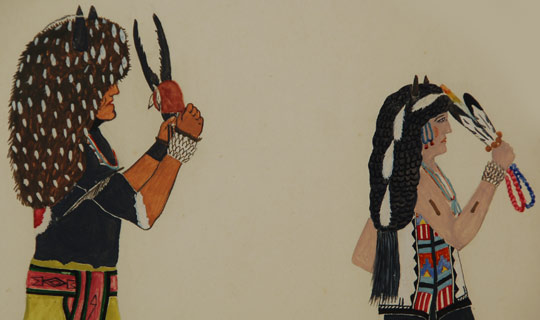Adobe Gallery Blog
Subject: Original Painting of a Jemez Pueblo Buffalo Dance
The plan for a painting studio at the Santa Fe Indian School had been four years in the making before it finally opened in the fall of 1932. Dorothy Dunn was in charge of the art department. It was in the second year of The Studio that Dorothy Dunn first mentioned Emeliano Yepa and she described him as painting pageantry. He was one of three students selected to paint murals in true fresco for The Studio and one of the residence halls. One of the mural paintings by Yepa was "A Summer Dance" (Corn Dance).
 In the fourth year (1935-36), a Museum of New Mexico exhibit was organized to present to the public works by the students. Frederic H. Douglas's review of the show included the following statement "Much fine art will come from this area, with its strong tradition in painting. No.125 by E. Yepa, displays the work of a painter who clings, at least in his pictures, to a style seen in the first days of the movement. His conservatism is to be commended, for while progress is desirable, a brake is often useful."
In the fourth year (1935-36), a Museum of New Mexico exhibit was organized to present to the public works by the students. Frederic H. Douglas's review of the show included the following statement "Much fine art will come from this area, with its strong tradition in painting. No.125 by E. Yepa, displays the work of a painter who clings, at least in his pictures, to a style seen in the first days of the movement. His conservatism is to be commended, for while progress is desirable, a brake is often useful."
An analysis of the works of all the students in the fifth year (1936-37) stated of Yepa "Emeliano Yepa had a somewhat stilted style which enhanced the formal patterns of ceremonial and small Jemez scenes he chose to paint. His brilliant palette brought animation and a note of daring to his balanced, conservative compositions."
The last mention of Yepa by Dorothy Dunn, in her book published in 1968, stated that "Emiliano Yepa, another fine artist of Jemez, is no longer living." There was no date given for his death. Jeanne Snodgrass, in her Biographical Directory published in 1968 lists the artist as Emilina rather than Emeliano but has no information regarding birth, death, or age. She states that the artist attended the Indian School from 1932 to 1937 and was included in a National Gallery of Art exhibit in Washington, DC in 1953.
This painting is of a Jemez Pueblo Buffalo Dance, a dance often seen during the fall and winter seasons. The costuming presented by Yepa is a very good representation of what one sees today at a Buffalo Dance. The men wear buffalo head covers and canvas skirts with a serpent encircling the mid-section and tin cones dangling from the hem section. The female wears a traditional pueblo dress and carries feathers in her hand. The painting is signed E. Yepa in lower right and on verso is rubber stamped The Studio U. S. Indian School, Santa Fe, New Mexico.
Condition: very good condition with only a few minor flakes of missing paint
Provenance: sent to us by a gentleman from Colorado
Reference and Recommended Reading: American Indian Painting of the Southwest and Plains Areas by Dorothy Dunn
Subject: Original Painting of a Jemez Pueblo Buffalo Dance
Artist: Emeliano Yepa (c.1920s- c.1950s)
Category: Paintings
Origin: Jemez Pueblo
Medium: watercolor
Size: 11-3/8" x 15-1/2" image; 16-3/4" x 20-3/4" framed
Item # C3355


